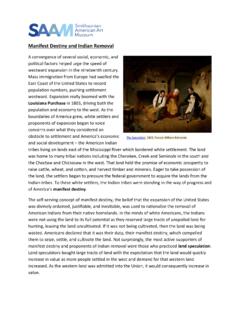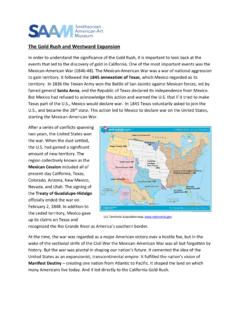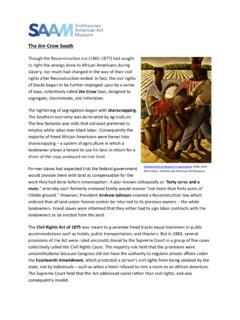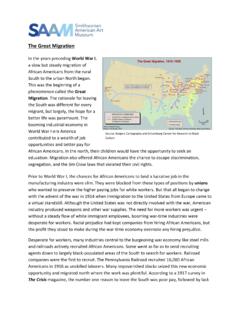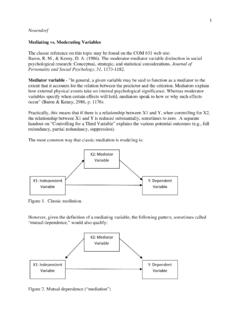Transcription of Loyalists and Patriots - American Experience
1 Loyalists and Patriots The Revolutionary War era was a time of immense turmoil for the American colonists, no matter where their allegiances lay. By comparing and contrasting these two artworks, we can examine both sides of the dispute over independence and how the issue directly affected the lives of those involved. Those who rebelled against the control and oppression of Britain were termed Patriots . The family of Mrs. James Smith and her grandson Campbell Smith were steadfast Patriots , with many family members participating in the military and early government in order to secure independence from Britain.
2 British Loyalists , like Robert Hooper, remained loyal to the English king during the war and made up approximately 15 to 20 percent of the population of the thirteen American colonies. Political affiliations at this time were often dictated by economic factors and not personal concerns. Joining the rallying cry of independence was not a simple decision. Wealthy merchants in port cities were especially adverse to independence as it would harm their business. Those in the importing and exporting business, like Robert Hooper, relied heavily on trade with England.
3 Their business was vital for providing for their families and so no matter their personal feelings, biting the hand that fed them was not an option. Perhaps not by coincidence, the painters that were commissioned to paint these portraits shared the political sympathies of their sitters; Charles Willson Peale was an ardent Patriot and a member of the Sons of Liberty, while John Singleton Copley, a family friend of Robert Hooper s, was a vocal Loyalist who was forced to flee to England to escape persecution for his political beliefs. Loyalists Loyalists were those in the colonies who remained loyal to the British crown during the American war for independence.
4 They were also known as King s Men, Tories, and Royalists. They considered themselves to be British citizens and therefore believed revolution to be treason. The majority of these Loyalists belonged to the wealthy merchant class in the colonies, their livelihood dependent on trade and good relations with Britain. Because of their strong Robert Hooper, ca. 1770-72, John Singleton Copley, Smithsonian American Art Museum affinity with Great Britain, it is not surprising that these colonists favored styles that were characteristically British, including the style of their portrait paintings.
5 British fashions and furnishings, designs and d cor all were in vogue for the colonial elite to emulate. Wealthy colonial men and women, particularly Loyalists , were enamored with the current trends in British portrait painting. While these men and women could afford to travel to sit for famed British artists like Thomas Gainsborough or Joshua Reynolds, many chose to employ an artist in the colonies who had similar training and stylistic attributes as Gainsborough and Reynolds. For the elite in Boston, only one artist had all of these qualities John Singleton Copley.
6 Not only was Copley trained in London, but his own personal political leanings were that of a Loyalist. The Hooper family of Marblehead, Massachusetts, a port town just north of Boston, were one of Copley s richest patrons and provided Copley with numerous commissions. From 1763 until Copley left American shores in 1774, he painted many members of Robert Hooper Jr. s family including his father, step-mother, and several of his siblings. In the colonies, to own a commissioned portrait indicated the owner s wealth and status because not everyone could afford to have their portrait painted.
7 This portrait of Robert Hooper Jr., painted before the American Revolution, is an image of a successful businessman. His gaze drifts towards the open window a nod to the source of his wealth, his mercantile and shipping businesses. Hooper grasps a stack of papers in his hands, perhaps a stack of shipping ledgers. The Hooper family owned the largest and most profitable shipping business in Marblehead, Massachusetts, and therefore had a considerable amount of social and political influence. They were well-known Loyalists , even allowing the British commander-in-chief, and then Massachusetts governor, General Thomas Gage to use their home as his headquarters prior to the Battles of Lexington and Concord.
8 The Hooper family were also vocal supporters of the royally-appointed governor of the Massachusetts colony, Thomas Hutchinson. Most Patriot-leaning colonists had viewed Hutchinson s performance in office as deplorable, accusing him of pushing a British agenda. He was politically polarized and was identified as the main proponent of the British taxes on the colonies. Yet several men in the Hooper family, including Robert John Singleton Copley Self-Portrait, 1780-1784, National Portrait Gallery, Smithsonian Institution Hooper Jr., lent their names to a published address to Hutchinson lauding his performance in office.
9 The address read as follows: We, the subscribers, merchants, traders, and others, inhabitants of Marblehead, beg leave to present your our valedictory address on this occasion .. our most sincere and hearty thanks for the ready assistance which you have at all times afforded us, when applied to in matters which affected our navigation and commerce .. our sincere esteem and . In your public administration, we are fully convinced that the general good was the mark which you have ever aimed at .. we beg leave to entreat you, that when you arrive at the court of Great Britain, you would there embrace every opportunity of moderating the resentment of the government against us.
10 The address was an obvious entreatment to King George III on the part of the colonial merchant class to see that their businesses would not suffer as a result of other colonist s treasonous activities. These public declarations understandably did not sit well with the Patriots . Given the already unfavorable sentiments towards Hutchinson and King George, the address had many in an uproar. These statements and other persistent acts of British sympathizing by the Hooper family and other Loyalists families caused them to be subjected to public humiliation and violence.



